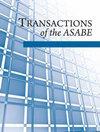仿生压辊类型、材料、速度和压实力对土壤压实特性的影响
IF 1.4
4区 农林科学
Q3 AGRICULTURAL ENGINEERING
引用次数: 0
摘要
仿生滚轮的性能优于传统滚轮。仿生脊状压路机具有较好的压实性能。不同材料轧辊的阻力大小顺序为:Fe360A钢> UHMWPE >搪瓷涂层。包装力是最显著的影响因素。为了降低土壤在播种过程中的粘附和滚动阻力,提高植株间距的均匀性,设计了仿生脊状压辊(BRPR)和仿生多面体压辊(BPPR)。此外,应用疏水材料,即超高分子量聚乙烯(UHMWPE)和搪瓷涂层,并与未涂层的Fe360A钢进行了比较。通过田间试验,研究了仿生压辊类型、材料、速度和压实力对土壤压实特性的影响。以常规压辊(CPR)为参照。测定了牵引力阻力(TR)、土壤容重(SBD)、土壤含水量(SMC)、出苗率(ER)和株距变化率(PCPS)。填料力是影响各项指标最显著的因素。各辊的TR、SBD、ER和ppps均随填料力的增大而增大,而SMC的损失减小。TR和SBD随流速的增加而减小。所有滚筒都达到了适当的玉米种子SBD。在播种后第3天,仿生压辊对土壤的TR、ppps和SMC均有显著影响。播后第3天,BRPR的ppps和TR低于BPPR, SMC高于BPPR。与CPR相比,所有仿生滚子的ppps均降低,ER和SMC均增加。含Fe360A钢的BPPR的TR略高于CPR,而其他仿生滚轮的TR低于CPR。BRPR使TR降低2.13%至22.30%,BPPR使TR降低0.35%至18.59%。两种仿生压辊的TR值均以Fe360A钢为最高,UHMWPE次之,搪瓷涂层的TR值最低。BRPR使pcp降低19.46% ~ 48.34%,BPPR使pcp降低9.69% ~ 36.99%。仿生滚轮使ER提高了2.17% ~ 11.36%。播种后第18天,当充填力为700 n时,仿生压辊的SMC比CPR高4.21% ~ 7.75%。本研究可为压辊的仿生设计、材料和受力选择提供参考。关键词:仿生,压实特性,搪瓷涂层,压辊,超高分子量聚乙烯。本文章由计算机程序翻译,如有差异,请以英文原文为准。
Effects of Biomimetic Press Roller Type, Material, Velocity, and Packing Force on Soil Compaction Characteristics
HighlightsThe performance of biomimetic rollers was better than that of a conventional roller.The biomimetically ridged roller had better soil compaction performance.The resistance order of rollers with different materials was: Fe360A steel > UHMWPE > enamel coating.Packing force was the most significant factor.Abstract. To reduce soil adhesion and rolling resistance during seeding and improve the uniformity of plant spacing, a biomimetically ridged press roller (BRPR) and a biomimetically polyhedral press roller (BPPR) were designed. Moreover, hydrophobic materials, i.e., ultra-high molecular weight polyethylene (UHMWPE) and enamel coating, were applied and compared with uncoated Fe360A steel. Field experiments were conducted to test the effects of the biomimetic press roller type, material, velocity, and packing force on soil compaction characteristics. A conventional press roller (CPR) was used as a reference. Traction resistance (TR), soil bulk density (SBD), soil moisture content (SMC), emergence rate (ER), and percent change of plant spacing (PCPS) were measured. The packing force was the most significant factor affecting each index. For all rollers, the TR, SBD, ER, and PCPS increased with increasing packing force, while the loss of SMC decreased. The TR and SBD decreased with increasing velocity. All rollers achieved proper SBD for corn seeds. The biomimetic press rollers had a significant effect on TR, PCPS, and SMC on the third day after sowing. The BRPR had lower PCPS and TR than the BPPR and higher SMC than the BPPR on the third day after sowing. Compared with the CPR, the PCPS for all biomimetic rollers decreased, and the ER and SMC increased. The BPPR with Fe360A steel had a slightly higher TR than the CPR, but the other biomimetic rollers had a lower TR than the CPR. The BRPR decreased the TR by 2.13% to 22.30%, while the BPPR decreased the TR by 0.35% to 18.59%. Moreover, both types of biomimetic press rollers had the highest TR values when using Fe360A steel, followed by UHMWPE, and the enamel coating had the lowest TR values. The BRPR decreased the PCPS by 19.46% to 48.34%, while the BPPR decreased the PCPS by 9.69% to 36.99%. The biomimetic rollers increased the ER by 2.17% to 11.36%. On the 18th day after sowing, the SMC was 4.21% to 7.75% higher for the biomimetic press rollers compared to the CPR when the packing force was 700 N. This study can provide a reference for the biomimetic design, material, and force selection of press rollers. Keywords: Biomimetics, Compaction characteristics, Enamel coating, Press roller, UHMWPE.
求助全文
通过发布文献求助,成功后即可免费获取论文全文。
去求助
来源期刊

Transactions of the ASABE
AGRICULTURAL ENGINEERING-
CiteScore
2.30
自引率
0.00%
发文量
0
审稿时长
6 months
期刊介绍:
This peer-reviewed journal publishes research that advances the engineering of agricultural, food, and biological systems. Submissions must include original data, analysis or design, or synthesis of existing information; research information for the improvement of education, design, construction, or manufacturing practice; or significant and convincing evidence that confirms and strengthens the findings of others or that revises ideas or challenges accepted theory.
 求助内容:
求助内容: 应助结果提醒方式:
应助结果提醒方式:


